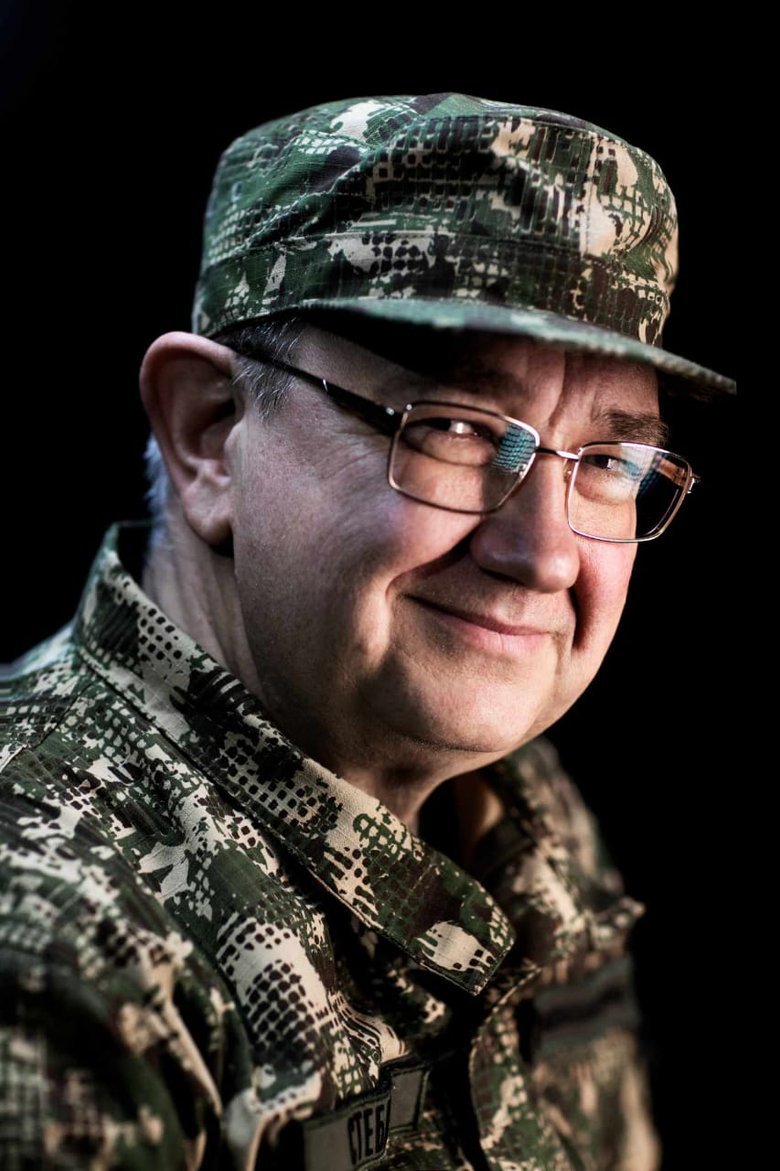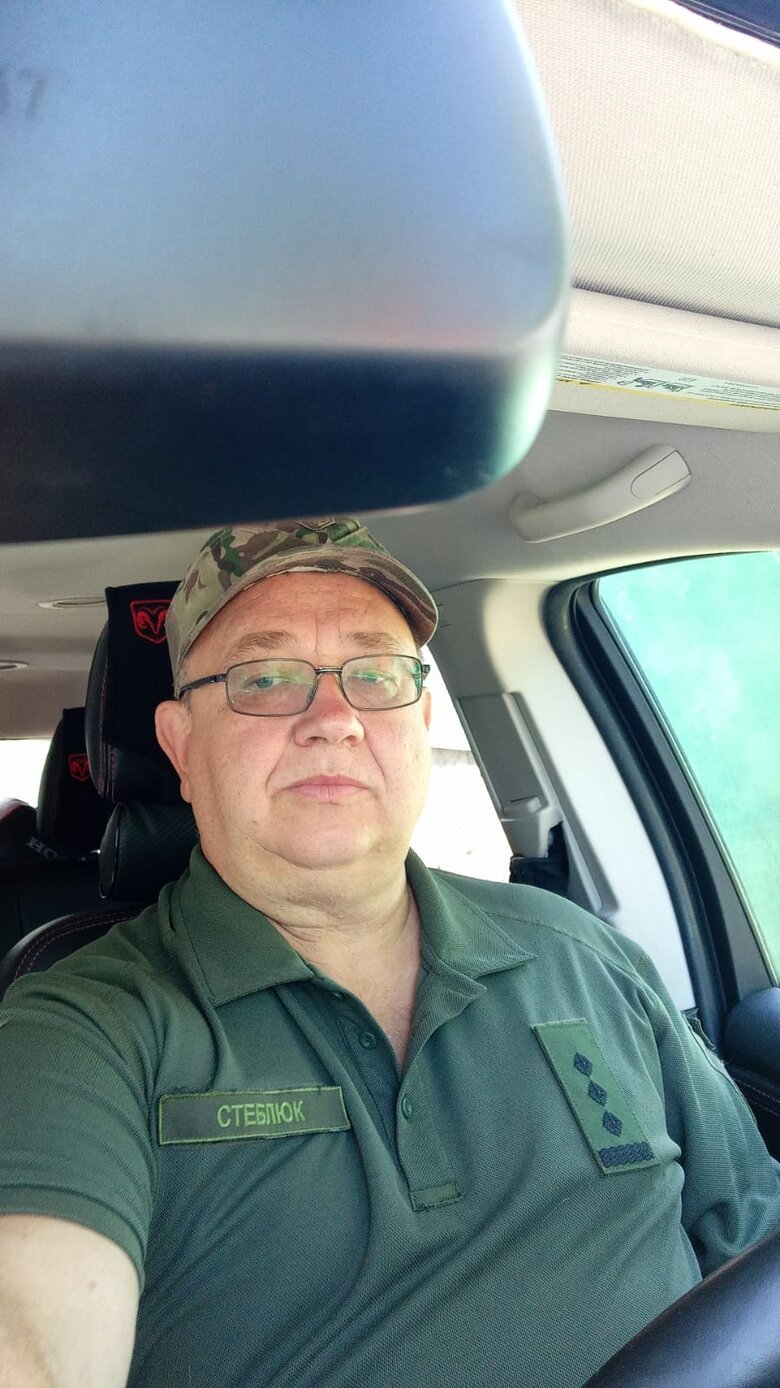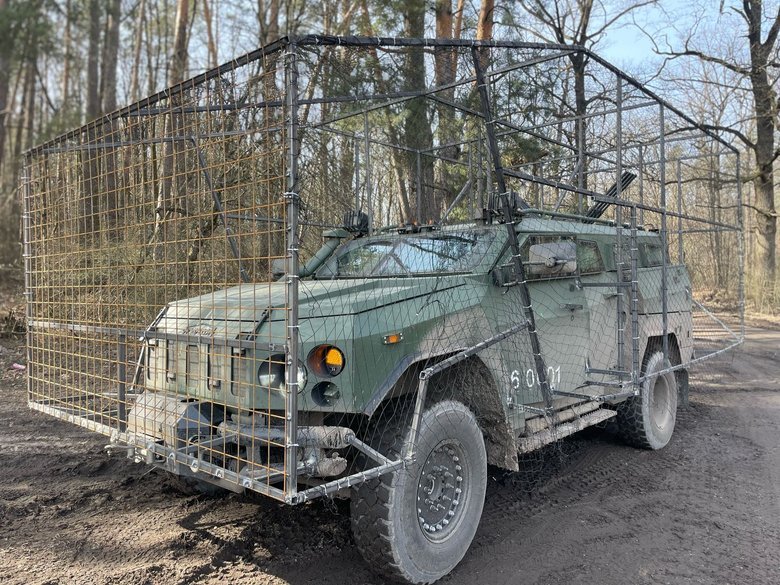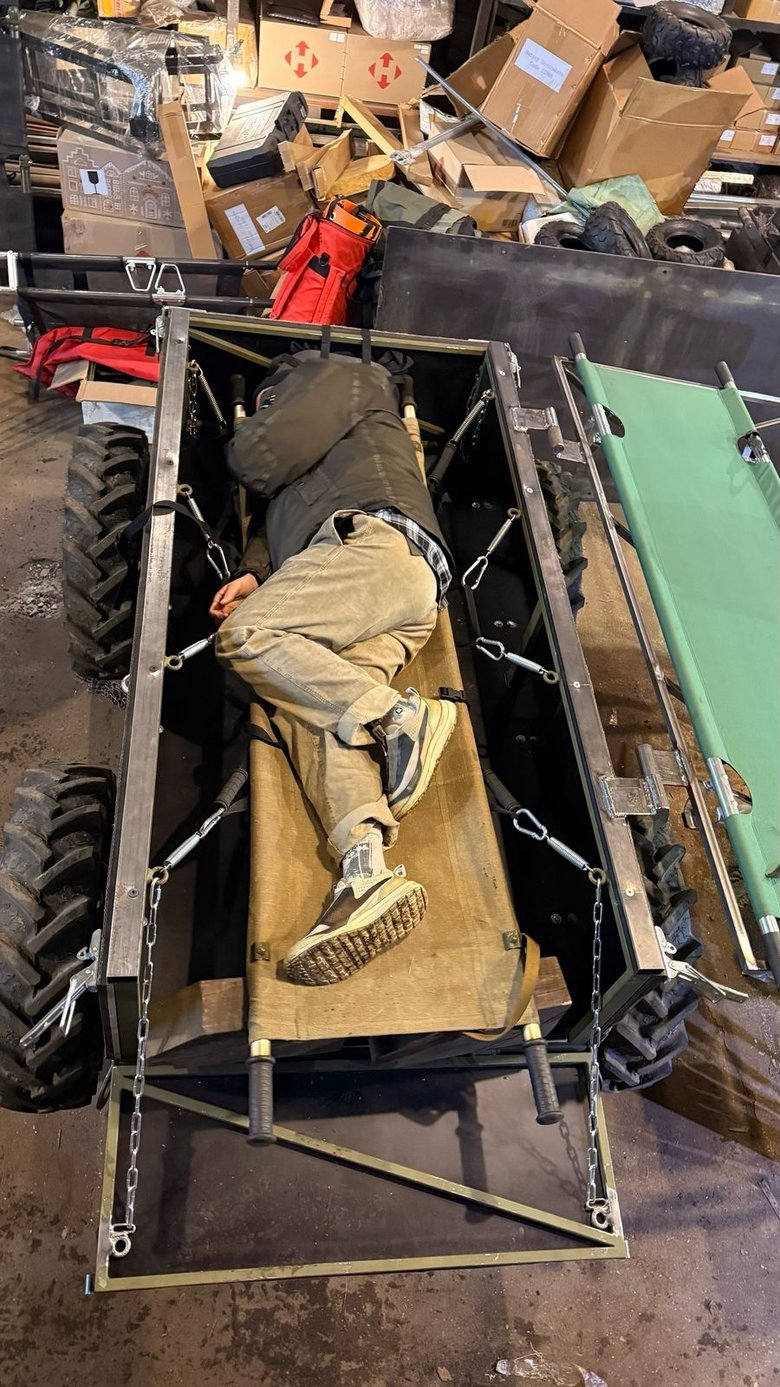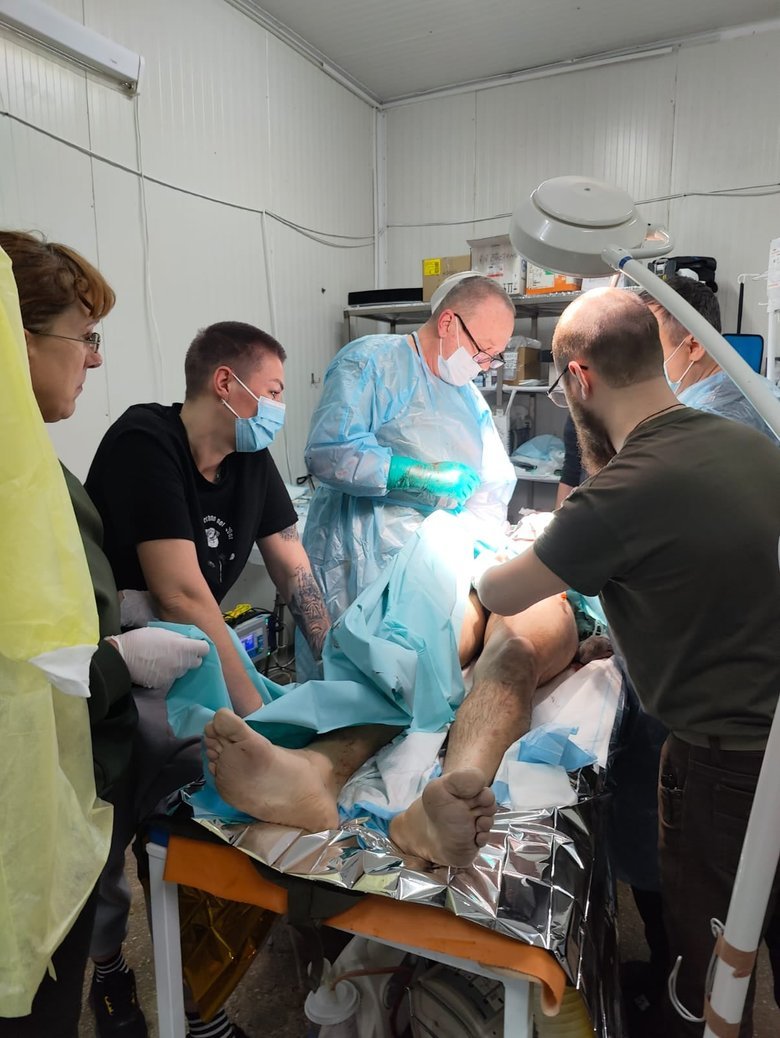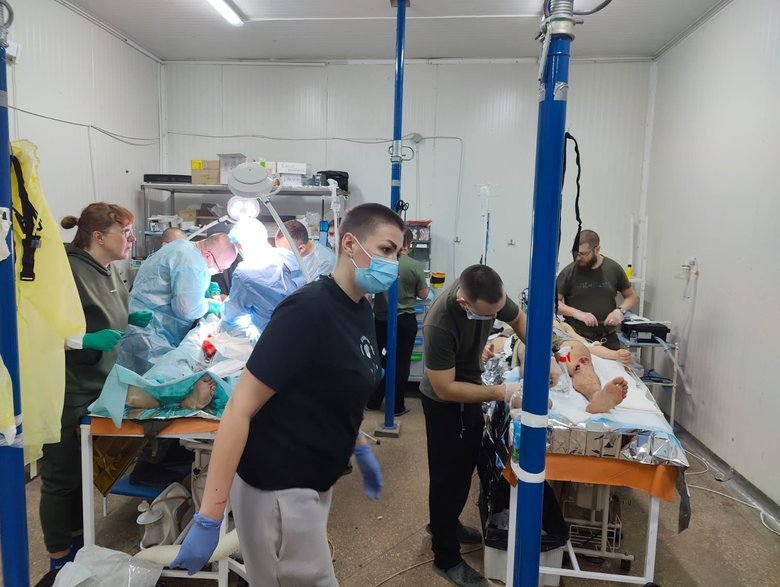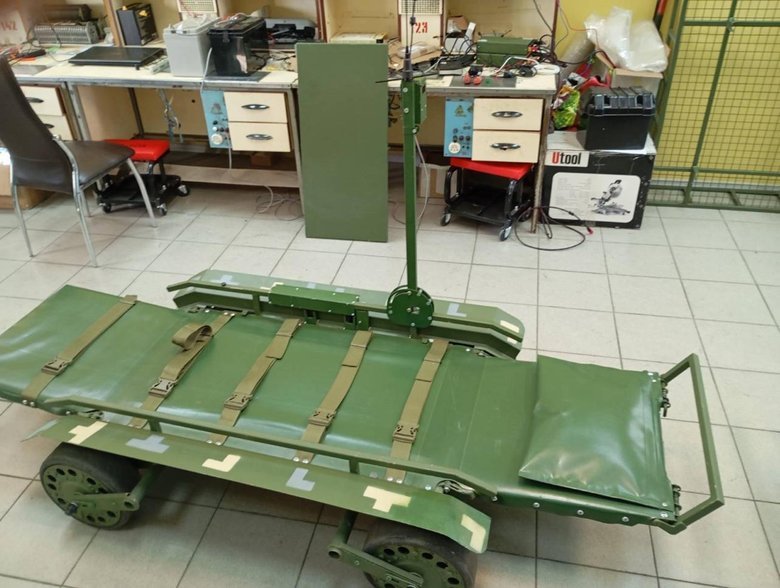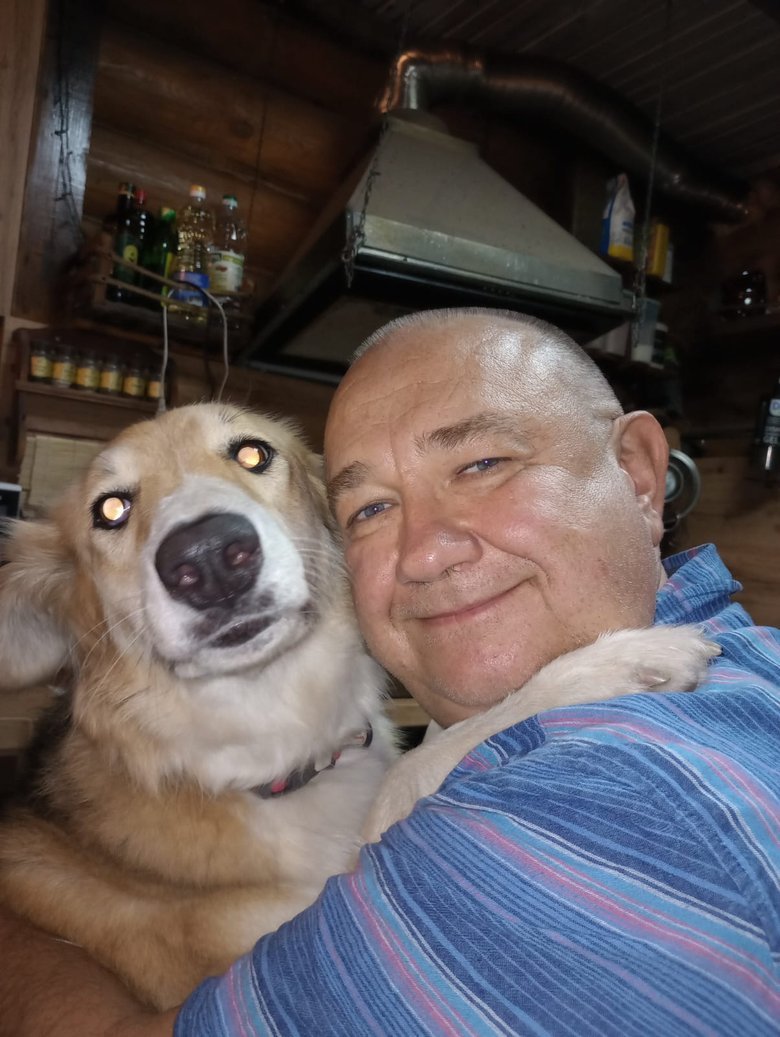Chief Medical Officer of National Guard of Ukraine Vsevolod Stebliuk: ’Doctors should not have mobilization exemption. There must be rotation’
Ukrainian medical scientist, public figure and bard, Doctor of Medical Sciences, professor, honored physician of Ukraine, laureate of the State Prize of Ukraine in Science and Technology, and a People’s Hero of Ukraine.
This is what Wikipedia says about Vsevolod Stebliuk.
The list could go on — yet for medics and soldiers, everything becomes clear once they hear Stebliuk’s long-standing call sign, Aibolit. Behind that name stands a lifetime of service to Ukrainian military medicine and far beyond. Everyone knows that Aibolit has been to every hotspot of this war, from Ilovaisk in 2014 to Kursk and Donbas in 2025.
Yet Censor.NET met with Stebliuk in his current key role, Chief of the Military Medical Directorate of the Main Department of the NGU, or, more broadly, Chief Medical Officer of the National Guard of Ukraine.
- Vsevolod, your workload is immense, even if you delegate part of your responsibilities to others. How does your workday begin?
- It starts with receiving information about sanitary losses, the number of wounded, and the occupancy of our medical facilities. That sets the tone for the entire day. When the report under code 200 (code 200 means KIA (Killed in Action) - ed. note) shows "zero," it means the teams did an excellent job, lives were saved, and there will be fewer tears and less grief today.
- And what about code 300?(code 300 means WIA (Wounded in Action) - ed. note)
- ..It prompts me to go through the reports, where exactly the casualties occurred, how the evacuation was carried out, and where those servicemen were transferred. Our National Guard units operate along the entire frontline. Accordingly, our medics are present everywhere. In general, the current system of medical support for the Defense Forces requires close coordination with the Medical Forces Command and with medical officers of the units on the ground.
- Without such coordination, it would indeed be impossible. Do you feel support or at least understanding, at the military-political level of Ukraine’s leadership?
- At present, we have a rather unique situation: there is effective cooperation between the legislative and executive branches. The parliamentary Committee on Public Health and Health Insurance is actively working to support military medicine.
- So you’re satisfied with the cooperation with the relevant committee? I ask because it’s not often that one hears praise for the country’s highest legislative body from the military…
- Yes, I am satisfied. They respond to our proposals. For instance, when it comes to mobilization issues, a very interesting draft law is now being prepared, and we are all taking part in its discussion.
We have a coordination center led by Deputy Head of the Presidential Office Iryna Vereshchuk. It’s a 24/7 chat that includes nearly 300 people, medics ranging from hospital commanders and heads of medical services in individual units to researchers and representatives of the Ministry of Health. This structure allows us to raise issues, set control points and deadlines, and monitor implementation. Our meetings are held online, and the very existence of this communication channel is extremely important. What used to stall for months at the level of administration and regulatory drafting now moves much faster. And that’s truly encouraging. Because without a proper regulatory framework, it’s very hard to operate. Right behind you stand NABU, the State Bureau of Investigation, the Security Service, and others...
- I can imagine.
- For us to work effectively, we need that regulatory foundation. So I will always be grateful to the management system that has come together. In fact, this experience should be studied not only by us but also by our international partners. Today, Ukraine’s military medicine is the most advanced and progressive in the world. Others want to learn from us and they should also learn how to navigate bureaucracy efficiently. We can see that even brilliant ideas our partners try to implement often get stuck in layers of bureaucratic obstacles. And they take a long time to be implemented.
- An acquaintance from the National Guard told me that Stebliuk has to feel everything with his own hands before approving it for use because he’s been through the lower levels of command himself and knows their problems firsthand. How does that "hands-on approach" work in practice?
- You know, it’s important for me to be where all this strategic planning is actually implemented. I’m a hands-on person, I’ve visited every stabilization point where National Guard medics operate and practically all hospital bases. I know the equipment in use and what’s still needed. Sometimes, when a stabilization point is short-staffed, I step in as an anesthesiologist. I can also fill in as a medic if needed. It’s crucial that everyone on the team knows their chief medical officer isn’t a desk-bound bureaucrat or even just a hospital administrator, he’s one of them. The greatest compliment I’ve ever received came at a stabilization point in the Kursk sector. I had just brought in patients from evacuation, and as I stepped outside for a smoke, I overheard one of the medics say something that will inspire me for the rest of my life: "The guardsmen are lucky, they’ve got a f***ing great chief medical officer."
- Yes, after such words, wings grow.
- I also try to test new equipment. For example, when one of the Ukrainian companies developed the Novator-S armoured ambulance, the team - the driver and doctors - first drove it. And then they told me about their impressions, and then I came and drove it myself for evacuation. To understand what could be improved.
- And what shortcomings did you find? It's interesting.
- It all started when we were driving along a field road at night. We were shaking and throwing. And I was driving in the cabin where the wounded were supposed to be. After driving a dozen kilometres, it became clear that the next step for improvement would be to develop and install a rear air suspension so that patients would not be thrown around so much.
The next point concerned the quality of night vision devices and improved visibility. After all, you need to drive at night without headlights, because headlights are always a danger. And evacuations take place mostly at night. We were driving, and the camera in the car gave us a picture as if we were driving through a snowfall. It was very, very unpleasant.
I also paid attention to the ranges of the electronic warfare equipment. Initially, the vehicle was equipped with a primitive electronic warfare device that did not cover all ranges, so there was a huge risk of damage. We travelled with different models of EW on other vehicles, talked to our drone operators and specialists, and multi-band (we won't give technical details) EW went into production.
Another issue we identified: at the time the vehicle was designed, its stretcher layout allowed for only one patient lying down and four seated. Obviously, no one would drive to a casualty collection point to pick up just one severely wounded person. To arrive and have nowhere to place him? So, we developed a new configuration that increased the number of stretchers for critically wounded patients to four (and if necessary, a fifth could be placed between the rows). We built a two-tier stretcher system with a proper loading mechanism. We also made improvements related to light masking and enhanced the interior ergonomics.
- For example?
- When you’re driving and working, everything must be within arm’s reach. Initially, the design placed the medical equipment box under the stretchers. We came up with a simple but effective alternative, hanging organizer panels, like curtains. Everything is laid out neatly there, allowing for quick access and efficient work.
These may sound like small details, but you don’t notice them until you’ve actually worked in the field. By the way, this vehicle operated in the Kursk sector, where it underwent field testing. Its tail number is 0001; the driver, Ramiz, and his crew saved many colleagues and patients. I remember one mission, we rushed into enemy-contested territory to rescue the crews of damaged medical vehicles from the Armed Forces. But even with improved EW systems, armor protection, and everything else, nothing guarantees full safety. There was a case when Russian forces attacked an ambulance transporting a critically wounded soldier with drones. The ambulance was hit, but everyone survived. Our team went in to extract them and transferred everyone into the Novator. The patient was in critical condition, on mechanical ventilation. The crew included a doctor, a paramedic, an orderly, all medics, and Ramiz was driving. Already on our side, at our checkpoint, an FPV drone on a fiber-optic link carrying a shaped charge struck the rear doors of the Novator. The entry hole was small, but the entire shaped charge went inside. Tragically, an anesthesiologist from the Armed Forces of Ukraine, who was accompanying the patient, was killed. The rest sustained concussions. The doors and frame were deformed, but Ramiz didn’t stop, he sped through the checkpoint straight to the hospital. They made it. The colleague was gone. It’s horrific. Every death is painful, but when it’s your colleague, inside an armored vehicle, when you thought the worst was over… that’s deeply, deeply heartbreaking.
- Eternal memory to your anesthesiologist colleague, and deepest respect to all others.
Let’s talk about the evacuation process. First, let’s clarify the terminology, since people often interpret it differently. How many stages of the evacuation process do you personally distinguish?
- It depends on the situation. Generally, how does it work? The picture of the frontline changes dynamically, and accordingly, the organization of medical aid and evacuation changes with it. Nowadays, there are no large platoon or company strongpoints — only scattered, well-camouflaged positions. The main fire contact now comes from drones, artillery, and airstrikes. The task is to hold off assaults and infiltration attempts. In this environment, tactical medicine skills are absolutely crucial. Every soldier must be trained and prepared to the level of a combat medic. If earlier we said that your guardian angel was the combat medic, today, above all, every serviceman must have a high level of medical training.
As for the stages of evacuation, it naturally begins at the point of injury. Mutual aid is vital here. The collection point is where the wounded are gathered and receive medical assistance from trained personnel, such as medical instructors or senior combat medics.
From the collection point, evacuation is carried out using armored or any available transport, including ground robotic systems. CASEVAC refers to such ad hoc evacuation. During CASEVAC, combat medics and medical instructors continue providing medical care en route.
The next stage is MEDEVAC, this begins at the level where a doctor or an experienced paramedic is present. MEDEVAC is conducted in equipped medical vehicles capable of sustaining life functions. Depending on the patient’s condition, evacuation proceeds either to a hospital or to stabilization points.
So, what is the purpose of a stabilization point? It exists to stabilize the most severely wounded patients who would not survive transportation, even the 20–40 kilometers, without life-saving interventions. These are the "red" patients. That’s precisely why stabilization points are established.
From there, tactical evacuation takes place — or MEDEVAC transports the "yellow" and "green" patients.
- Could you please explain this color differentiation?
- "Yellow" refers to patients whose treatment can be delayed for several hours. "Green" are those who must receive medical assistance within a day. They are taken to forward surgical departments or mobile hospital units, where such care is provided. "Red" patients from the stabilization point are also transferred there.
From these forward surgical units or forward hospital bases, patients are further distributed among healthcare facilities, possibly civilian hospitals staffed by military teams, or military hospitals located deeper in the rear, for definitive treatment to eliminate the effects of injury. In other words, for extended medical care. After that, they are moved to rear bases. This stage is known as strategic evacuation, involving buses, medical trains, helicopters, and other means of transport.
Ground robotic systems — hope for frontline evacuation
- Step by step now. In one of your interviews, you mentioned NATO’s "golden hour of evacuation" and how difficult it has become to meet that standard, to get the wounded to a stabilization point within that time. I’ve read several publications by your NATO colleagues, they themselves admit that in modern warfare, medical evacuation assets are constantly at risk. They specifically cite lessons learned from the Russian-Ukrainian war. They see only one real alternative to the golden hour, prolonged field care. Do you agree with NATO experts on this?
- Absolutely. In fact, they’re learning from our experience. It is precisely prolonged field care that allows us to save lives, to keep a serviceman in a stable condition until evacuation becomes possible. This care is organized at the casualty collection points, in shelters, what we call the "yellow zone" of combat. One crucial aspect is the timely delivery of medical supplies. The backpacks used by combat medics and medical instructors contain everything necessary for initial care, but they don’t account for certain needs, such as blood transfusions. It was during this war, for the first time in the world, that blood transfusions were performed in shelters within the yellow zone, practically at the edge of the red zone.
One of the episodes of this war. On the enemy's territory
- And the red zone is…?
- The red zone refers to care under fire, medical care delivered while under enemy fire. Obviously, blood transfusions are not performed under direct fire. Once there is an opportunity to deliver blood products, however, blood was transported by quadcopters; warming packs were airdropped. This practice originated with Azov and is now spreading to other brigades. It saves lives and helps casualties hold on until evacuation is possible.
- A question about evac vehicles. When you speak with medics who bring the wounded to stabilization points and ask them what they raise funds for, the answer is almost always the same: repairing our vehicles. Often, there’s nothing to use for repairs, so they improvise. They make appeal videos, reach out to popular bloggers for help.
How is this painful problem handled within the National Guard medical forces? It’s painful because if an evac vehicle is out of service, the wounded won’t reach the stabilization point.
- In 2022–23, we relied heavily on volunteer equipment, and we are deeply grateful to those who stepped up during the hardest moments. Many of those vehicles are still in service and are generally registered with the National Guard. Today, we virtually no longer have so-called "wild" equipment. If a vehicle is grounded, funds are allocated for fuel and repairs. Yes, that takes time. But the National Guard has planned measures so we can carry out repairs. If quick fixes are needed, units request them directly. Each unit has its own funds that help; in some cases issues are solved locally.
We are procuring new evacuation vehicles. For Interior Minister Klymenko, saving lives is a top priority, so we receive funding to the greatest extent possible. We purchase new medical transport and try to distribute it first to frontline combat brigades. We rotate vehicles: equipment that has reached the end of its service life in frontline units is sent to rear units, and from there, the better ones are redeployed forward. Overall, all new transport, both armored and unarmored, is prioritized for our two corps: "Khartiia" and "Azov."
- Now I’ll ask a few questions to Inspector Stebliuk. I mean those weeks when you come to see how things actually work on the ground. If you look inside an evac vehicle, maybe even ride along with a crew on their route, what absolutely must not be present in that vehicle?
- In that vehicle and in its crew there must be no sense of fear or resignation. There must be an appropriate moral-psychological state. Everyone must operate with confidence, understanding that emotions come later, first and foremost, it’s the job. The chief medical officers who form these crews understand this perfectly.
What else must not be there? Disorder. Medical supplies must not be strewn about; bandages should not be left open. The vehicle must be as tidy as possible when it goes on a mission. Naturally, during evacuation there will be blood and everything else, and you may end up dropping packaging from meds or catheters at your feet. But at dispatch, the vehicle must be clean.
Most importantly: there must be no risk that, if hit, the vehicle will turn into a bomb. Accordingly, during the tactical evacuation phase we turn off compressed oxygen cylinders. All ventilators must run off concentrators, low-flow, turbine-driven units.
- Right, because a ballistic hit to an oxygen cylinder…
- …immediately turns everything into a bomb, into a crematorium. Everything burns out within a minute; people die. That is probably the single most important piece of equipment that must not be present, along with other flammable materials. We moved away long ago from ether anesthesia and other substances that could trigger fires or explosions. Today there are options to conduct evacuations safely with regard to the explosiveness of oxygen cylinders, both during transit and at stabilization points.
- Are there things you dream of having in our evac vehicles?
- Absolutely. I would like every evac vehicle to carry a medical "Javelin", a multifunction unit that combines an oxygen concentrator, a ventilator, a cardiac monitor, and a suction device. We do have these units, but each costs roughly $150,000. Clearly we cannot fit a medical Javelin into every ICU ambulance. We place them with experienced units, because you must be trained to operate them. Incidentally, portable oxygen concentrators are already appearing — about the size of a "Mucha" grenade launcher, I won’t name the brand... They provide up to 5 liters of oxygen per minute and are an important lifesaving resource.
I would also like every vehicle to be fitted with monitoring systems. Those are integrated into the medical "Javelins"… It frees up valuable working space. And I’d like all CASEVAC vehicles to be fitted with anti-drone nets and protective cages. That’s not just a dream anymore, we’re already implementing it.
- Let’s move on to stabilization points. When you, as the head of the National Guard’s medical service, arrive at one, what must not be there? What people, what situations?
- The most important thing is that as few people as possible, only those directly involved, know about the existence and location of the stabilization point. The enemy targets such sites. Recently, we lost a colleague, an anesthesiologist, a National Guard doctor. He was killed at an underground stabilization point because he stepped out into open ground. Even then, it wasn’t fully open, he was in a dugout, receiving a wounded soldier, when the area was struck by guided aerial bombs. Our colleague was killed while on duty at an underground facility. That’s why strict camouflage, restricted information access, and radio silence are essential. No one should be using mobile networks. There must be absolutely no hints about the location of a stabilization point.
What else must not be there? Probably, random people in the team. A stabilization point must be staffed by like-minded professionals who trust one another — no conflicts, no quarrels, nothing that undermines cohesion. That’s critical for both safety and efficiency. There should be no "military-medical tourists" people who come just to earn combat veteran status from the rear. You know how it happens: someone is sent "for a week or two to help at a stabilization point," gets the veteran status, goes back, and treats it like a field trip. That must never happen. Those who come to work at stabilization points or anywhere in the combat zone must understand this is not an adventure, not just a temporary assignment, not a way to earn bonuses. It’s a long game, real work. Only when you stop counting the days until you can leave and focus fully on the mission can you plan effectively, manage your work and rest time, and ultimately increase operational efficiency.
What matters to me at a stabilization point? Medical equipment at every stabilization point must be modern and fit for purpose. It’s important to me that personnel who spend most of their time underground have decent living conditions, a place to wash, a place to sleep. I always ask where the food comes from: is it cooked on site or delivered, and if delivered, in what form. I’m always happy to sit down and have a meal with my colleagues at a stabilization point, because I want to give them everything they need to work effectively.
Another key factor is staffing levels, enough specialists so people can rotate out to rest points after shifts. Burnout must be prevented. Burnout is everywhere right now. I have burnout myself. Sometimes you feel defeated and think: I can’t do this anymore, I don’t want to. For me it’s more tied to administrative and organizational work than to frontline duties. If I were allowed, I’d gladly hole up at a stabilization point for three months and work there with great pleasure, applying my experience and skills. But sadly, that’s not possible…
About burnout: burnout at stabilization points is simply unacceptable, because every second counts there. You must stay fit, physically and psychologically.
- One company medical commander told me that in his work it’s crucial to notice when the light in a doctor’s eyes goes out.
- He was absolutely right.
- …and if that light goes out, you must quickly send them on leave, into rehabilitation, or maybe have their spouse come — something like that.
- That brings us to commanders, heads of medical services. I believe the National Guard has the best medical commanders. Why? Because they come from diverse backgrounds. Some are graduates of the Military Medical Academy; some came from civilian practice; some worked in large private medical centers. But all medical commanders have come up through the ranks of the medical company, at minimum through medical posts. They all know how a stabilization point works. They’ve smelled the smoke, felt the blood, they know what it looks and feels like. They know these things from the inside. That’s why the vast majority lead correctly. I trust them, and I’m proud we’ve built such a team of military medics in the National Guard, at least in the combat brigades. I spend less time in rear brigades, there’s important work to do there too, but my heart and soul belong to the combat medics on the front line.
- What do foreign colleagues say about your stabilization points? Have you ever taken them there or met with them on site?
- I haven’t had the chance to speak with them directly. Perhaps they have visited as part of delegations at some point. I’ll say again: a stabilization point is not a tourist site or a location for photos and videos.
That said, I have been in contact with foreign combat medics who fight alongside our Defense Forces. Many excellent specialists have joined us and continue to work here. I can’t name them, but some have been with us since 2014. I have one friend, a French military physician who was here during the Maidan (and, by the way, was quite skeptical about our Revolution of Dignity at the time). He stayed, and since 2014 has carried out his mission. Since the start of the full-scale war he has barely left the frontline, has sustained several wounds and concussions, recovered, and returned. Back in 2014 he told us how things were organized in Iraq and Afghanistan; today he could teach other colleagues using our example of what works.
I also have a wonderful friend, practically a sister, an American who has been fighting with us since early 2022 and with whom I’ve been on combat missions. She’s a military nurse who completed two deployments to Afghanistan with the U.S. Army. Today she’s here and always says about her future plans: "I’ll find myself a real husband, a Ukrainian, buy a patch of land, raise chickens, and live here after the war." That’s the dream of my sister-in-arms.
- A lovely dream. In general, this war, a terrible disaster for our country, has nevertheless brought many decent foreigners to our side.
- I periodically attend NATO school courses for the medical command cadre. These are regular professional courses, and their curricula are evolving even there. Interest in our experience is huge. I’m currently preparing a lecture for students at that school. I can see how seriously it’s received. On my most recent trip to the NATO school, the greatest interest came from Norway, Denmark, and Germany; representatives from those countries requested materials. Everything I present is cleared with our relevant services, I have counterintelligence approval and the necessary security clearances for my presentation. There is genuine interest. Cooperation with the Baltics is especially engaging because they are already implementing preventive measures at home; they are realistically preparing for the possibility that aggression could be directed at them.
- Yes, they study our experience much more closely than the countries that are far removed from this war.
- Absolutely. And it’s often unpleasant to talk with some representatives of post-Soviet states. They’re also included in NATO’s Partnership for Peace program. Among them are people from countries that even belong to the CSTO. They don’t get full access to everything, but they are involved in certain aspects. And you know what really hurts to see? Representatives of post-Soviet countries whose governments claim to be oriented toward the European Union, yet the Soviet mindset is still very much alive in them. And when they start telling me, "Come on, try to end this war somehow, we were all brotherly nations once…"
- I can imagine how that kind of "brotherhood" makes your skin crawl.
- These are not young people; they’re my age. And they’re quite high-ranking medical officials in their countries. Ordinary people don’t go there, these are courses for senior medical officers. Hearing such words is deeply painful, especially when you have your own family history of fallen heroes.
- It’s good that we’ve come a long way toward Europe and left behind that Soviet-style "brotherhood."
- Exactly. I simply don’t speak with such people. I don’t want to tell them that I’ve buried many close friends and relatives who should still be alive. My family has felt this loss too. I just don’t want to talk about it. They won’t understand, no matter what you tell them or show them. Until it touches them personally, no one truly understands. But it is our duty to educate them, to convey our position, to teach through our experience.
- Let's move on to HR policy. You know the medical labor market well. Roughly what percentage of qualified doctors have left the country?
- I can’t say the exact percentage, but a lot have left. And not only doctors. We’re facing a shortage across all categories of medical personnel, but especially among mid-level staff. Why? Because traditionally, the vast majority were women. And many of them have gone abroad. Those who stayed have children and are exempt from mobilization, and so on. So it’s a very serious problem. As for physicians, the blanket mobilization exemption for medical personnel assigned to state and municipal healthcare facilities has led to a severe staffing problem in the military medical service.
- Yes, company medics have complained to me about that too.
- We discuss this issue constantly. In fact, the Verkhovna Rada Committee on National Health has prepared a draft law on the rotation of medical personnel. Everyone was involved in working on this bill, the Ministry of Health, the Ministry of Defense, the Ministry of Internal Affairs, and others. It was discussed both at the committee level and within the working group led by Iryna Vereshchuk. It will soon be submitted to Parliament. I won’t reveal the details just yet, otherwise some might start looking for ways to avoid it early. But I already mentioned the 100% exemption from mobilization. There was a request to lift some of those exemptions. So, fine, the Health Ministry passed along lists for de-exemption to the hospitals. And who did they release first? Those who weren’t useful to their hospital administrators…
- "It is Gloucestershire kindness"
- Exactly. At the last committee meeting, Mykhailo Radutskyi cited a very telling example. He said: "I looked at one hospital, a trauma unit with 25 beds, and there are 20 trauma surgeons on staff. Each one officially holds a quarter-time position just to stay on the hospital roster and keep their exemption." What does that tell us? That many of them continue working comfortably in private clinics. And here they are exempted from mobilization.
- And what should they do?
- I believe that there should be no military exemption for doctors. There must be rotation. The law prepared by the parliamentary committee together with our professional community is intended to address exactly this issue. Every doctor is a potential military doctor. We have reinstated military departments at medical universities, where reserve officers will be trained. That’s a positive step. But it will take time before graduates of these programs are ready. Yes, that’s work for the future, a long game. What we need today is an effective mechanism. And let’s be honest: most doctors have various ways to avoid mobilization. One of them is claiming disability. And as for draft evaders in the medical sector — that has, in fact, worked to the detriment of our state.
- Everyone with a clear mind understands the need for that. Still, that’s the stick, a necessary stick, but there should also be a carrot. Within the National Guard’s medical service, have you been able to implement social packages or pay levels that could attract good professionals?
- The problem of motivation and incentives isn’t unique to the National Guard. The Ministry of Internal Affairs has issued an order guaranteeing additional monetary rewards for medics who work at stabilization points or carry out evacuations. But even so, it’s still not enough. You look around and see that a warehouse loader at some supermarket chain can earn 30–50 thousand hryvnias a month. Meanwhile, our doctors who come for their Basic Combined Arms Training period earn the minimum, just over 20 thousand, until they receive their officer rank. After completing the three-month training and obtaining their initial officer rank, they’ll earn around 30 thousand. In the combat zone, of course, they receive additional bonuses.
- It's not much.
- You see, without raising the pay for all servicemen, I emphasize, for all, we’ll never be competitive. It’s not enough to say, "You’ll get bonuses for combat missions." Yes, they do, but there must also be a guaranteed base increase. As far as I know, the state budget already includes a provision to raise pay for all military personnel. When we invite someone to sign a contract or mobilize, we must be able to tell them: "You’ll have a decent salary." Think about it, a doctor in a private clinic earns at least 50–60 thousand hryvnias a month. He has a family. And we bring him in for 30 thousand. He’ll ask, "Why should I do this?" Then he’ll look for ways to get a disability certificate or find some other loophole, simply to keep providing for his family. The same applies to other professions too. But right now, we’re talking about doctors.
- I also wanted to ask about your network of mental rehabilitation centers for National Guard servicemen.
- We’re working on that, because mental health is an extremely important component. I always say: in war, there are wounded bodies and wounded souls. There is no wounded body without a wounded soul, but there are psychological injuries, changes in mental health, that can last a lifetime and even lead to disability. Today, the state of a serviceman’s psycho-emotional and mental health is one of the key factors determining combat readiness. Within the National Guard, we’ve built a full system and regulatory framework to conduct psychological rehabilitation. We try to organize these programs within our own units as much as possible. Because yes, you can send someone to an Interior Ministry rehabilitation center, where psychologists and doctors will work with them in perfect conditions, with pools and mineral water, but without military psychologists beside them, without comrades-in-arms who are also medics and have been through combat themselves, such rehabilitation simply won’t be effective.
Actors of the Ivan Franko National Drama Theater are frequent guests at the psychological rehabilitation center (among them Honored Artist Mykhailo Kukuiuk and People’s Artists Bohdan Beniuk and Oleksandr Pecherytsia.)
Unique plastic and reconstructive surgeries are performed by the Medical Centre's specialists in cooperation with scientists from the Bogomolets National Medical University
- I agree with you.
- I believe that the National Guard has developed the best courses for decompression and psychological recovery. In this collaboration, practical psychologists from the Psychological Support Directorate work alongside psychologists who have experience providing psychological support to entire brigades. Also involved are psychologists, psychiatrists, and rehabilitation specialists from medical institutions — particularly from our medical center.
I want to emphasize our medical center, because 90% of its staff have served in combat zones. They speak the same language as the soldiers. They know the realities on the ground. They already understand the needs. We will continue improving the material and technical conditions for carrying out rehabilitation, but it is crucial to preserve and develop the field of mental and psychological health within the National Guard’s own institutions.
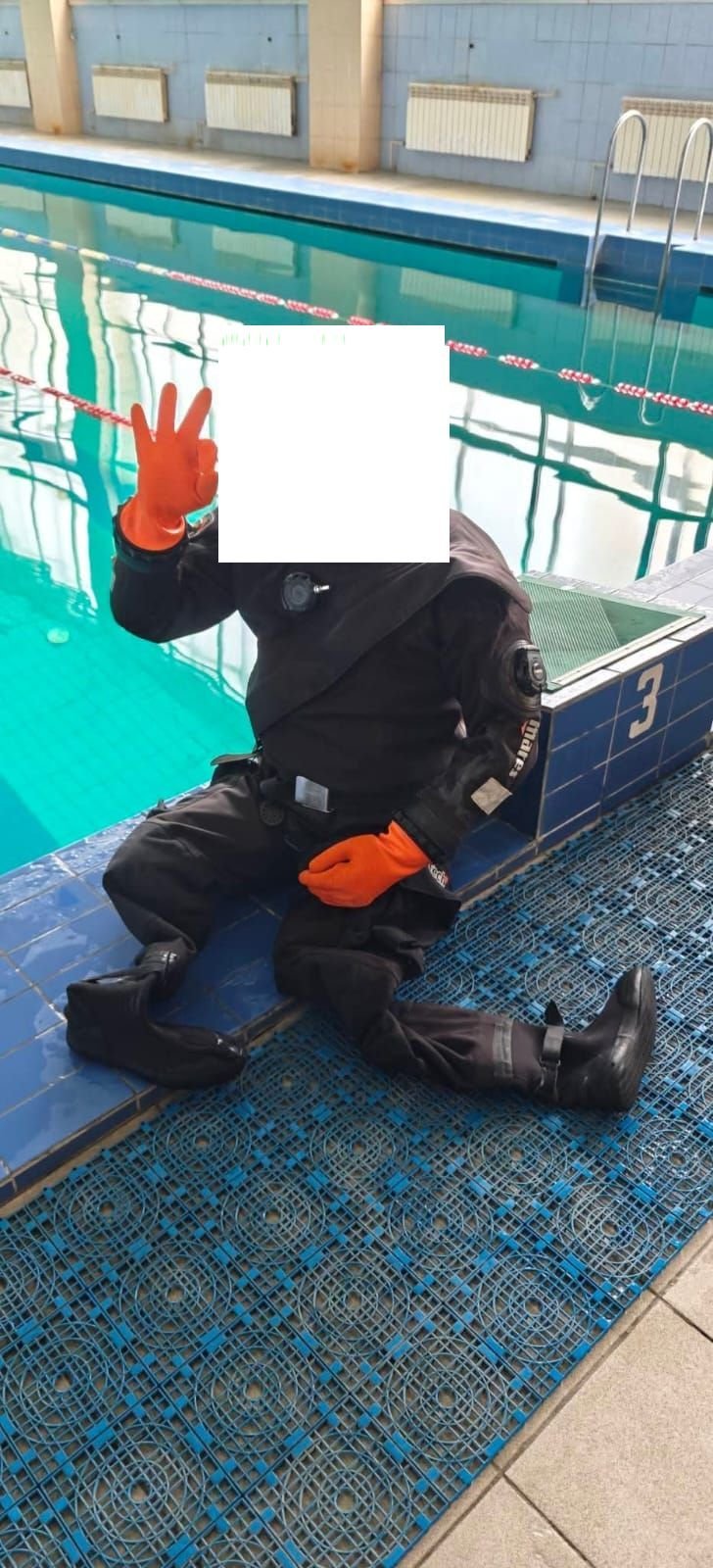
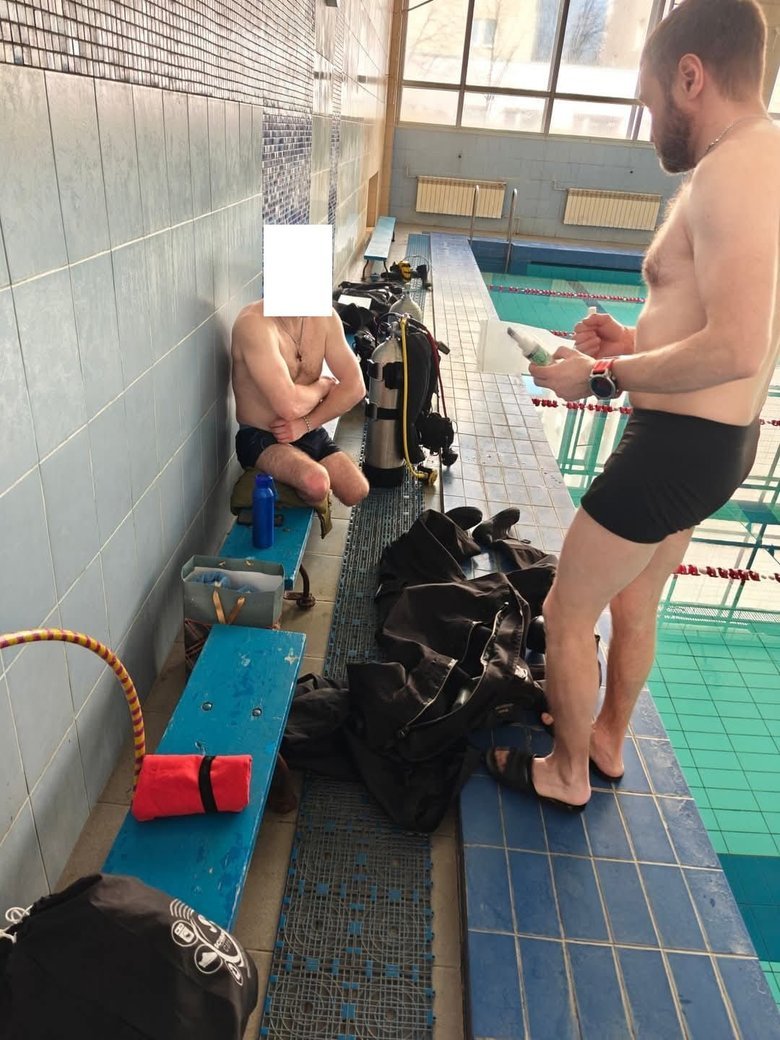
Scuba diving is part of the psychological rehabilitation program under the guidance of an experienced instructor, Captain Pavlo Bohdan of the National Guard.
- Vsevolod, how do you, as they say these days, take care of your own mental health? What do you do?
- That’s an interesting question. My service record is approaching thirty years. I began serving in 1993, though there were some breaks. And I’ve seen everything. Combat injuries, losses, you learn to accept them simply as grief. I buried my nephew, a young senior lieutenant of the Air Assault Forces, we thought he was our hope, the future of our army. He was a company commander and was killed in 2023. I’ve buried many friends, men I fought alongside in Ilovaisk. My family took in the daughter of my fallen comrade, she was left a complete orphan.
My soul has grown numb to all that. What my mind and heart still can’t accept, however, are the absurdities I sometimes face when dealing with people far removed from the professionalism of military medicine.
- Could you give a few examples of those absurdities?
- When someone who has never had anything to do with military medicine or medicine at all starts telling you that you’re applying a protocol or directive incorrectly, without realizing that it simply doesn’t apply to the situation at hand. Or when people who only started working in this field two or three years ago try to lecture me on how psychological rehabilitation should be conducted while I’ve been doing this work in the Armed Forces since 2014. I was one of the founders of psychological rehabilitation within the military, alongside outstanding specialists. I’m the author of textbooks, methodological manuals, and most importantly a practitioner in this field. And then someone comes along and tells me, "That’s not how it should be done"? That’s the hardest part. But at this point, my mind has learned to filter what’s real from what’s not. My heart has hardened when it comes to personal offenses or emotional wounds.
But I digress. How do I recover? Through my family, my son, my grandson, and my beloved wife, who’s always by my side. And through my pets the ones I took in during the liberation of the Kyiv region.
The dog Lusia — an IDP (internally displaced pet ) from Kherson.
- It’s worth noting that your beloved wife is a psychologist. In that sense, you’re quite well taken care of!
- That’s true. But under no circumstances do we have a "psychologist–client" relationship, that would be unprofessional and unacceptable. What truly matters is the sense of spiritual connection.
Once, after Ilovaisk, someone told me, "You’re not normal, you need to see a psychologist!" I replied, "You won’t believe it — that’s what I do 24 hours a day." And honestly, what saves me are my pets, my friends, those brief, warm moments of genuine human connection.
Yevhen Kuzmenko, Censor.NET

